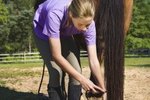
A horse who wants to kick is a danger to all: humans, other horses and even the kicking culprit -- who can injure himself in the process. Unless there’s a physical reason, kicking is a learned behavior. Your horse may have had to defend himself against aggressive horses in the past. Or Scout has not not had proper training or is bored or stressed. Breaking the habit takes patience, and you may need to try several approaches.
Physical
As with any negative behavior or habit, rule out a physical issue, particularly if your horse kicks while you are riding him. This is particularly true if he kicks when you are riding alone without other horses around him or if he kicks under saddle but not on the ground. Pay attention to when Scout kicks when you ride. If it’s when he feels your leg pressure, or when you ask for an upward transition to a faster gait such as a canter or lope, check for hind end issues such as sore stifles, lower back or hocks.
Ground Training
As an instinctive herd animal, horses behave according to herd pecking order. Horses fighting for dominance often display aggressive behaviors -- like kicking -- as part of the process until the other horses back down and show respect. Take your horse in a round pen and move him around it, changing directions several times. Wave a rope or lunge whip at his hindquarters if he turns to face you or comes toward you without your permission, but don't hit him. Scout should change direction by turning away from you until his aggressiveness stops. Repeat these maneuvers using a rope halter with a long lead until he accepts you as dominant.
Ponying
If Scout kicks at other horses while you are riding him, “pony” him with a friendly horse. Ponying is only for experienced riders or trainers, so ask for help if you are inexperienced. Mount a calm horse that your horse likes, riding Dolly while leading Scout alongside her. Keep Scout 4 to 6 feet from Dolly, just at her hip. Coil the lead rope in your hand so you can let go if Scout reacts violently. Do short practice rides and watch for any aggressive signs. Progressively do turns and halts until Scout behaves perfectly. Then try riding him with other horses. If he still kicks, continue with the ponying lessons.
Tools
Simple negative reinforcement can break a kicking habit. The key is for your horse to prompt the negative consequence. If Scout routinely kicks in his stall to get attention or demand food, try a kick chain. This is a leather bracelet with a chain attached. Buckle the bracelet on the kicking leg. When your horse kicks, the chain hits him in the leg. Another device operates through sensors attached to stalls. When the sensors detect kicking, the horse gets squirted with water. Once horses realize they are causing these negative consequences by kicking, they often stop. If Scout is simply bored, provide him with stall toys designed to relieve boredom.
References
Resources
Photo Credits
-
Jupiterimages/BananaStock/Getty Images
Writer Bio
Based in Central Texas, Karen S. Johnson is a marketing professional with more than 30 years' experience and specializes in business and equestrian topics. Her articles have appeared in several trade and business publications such as the Houston Chronicle. Johnson also co-authored a series of communications publications for the U.S. Agency for International Development. She holds a Bachelor of Science in speech from UT-Austin.




